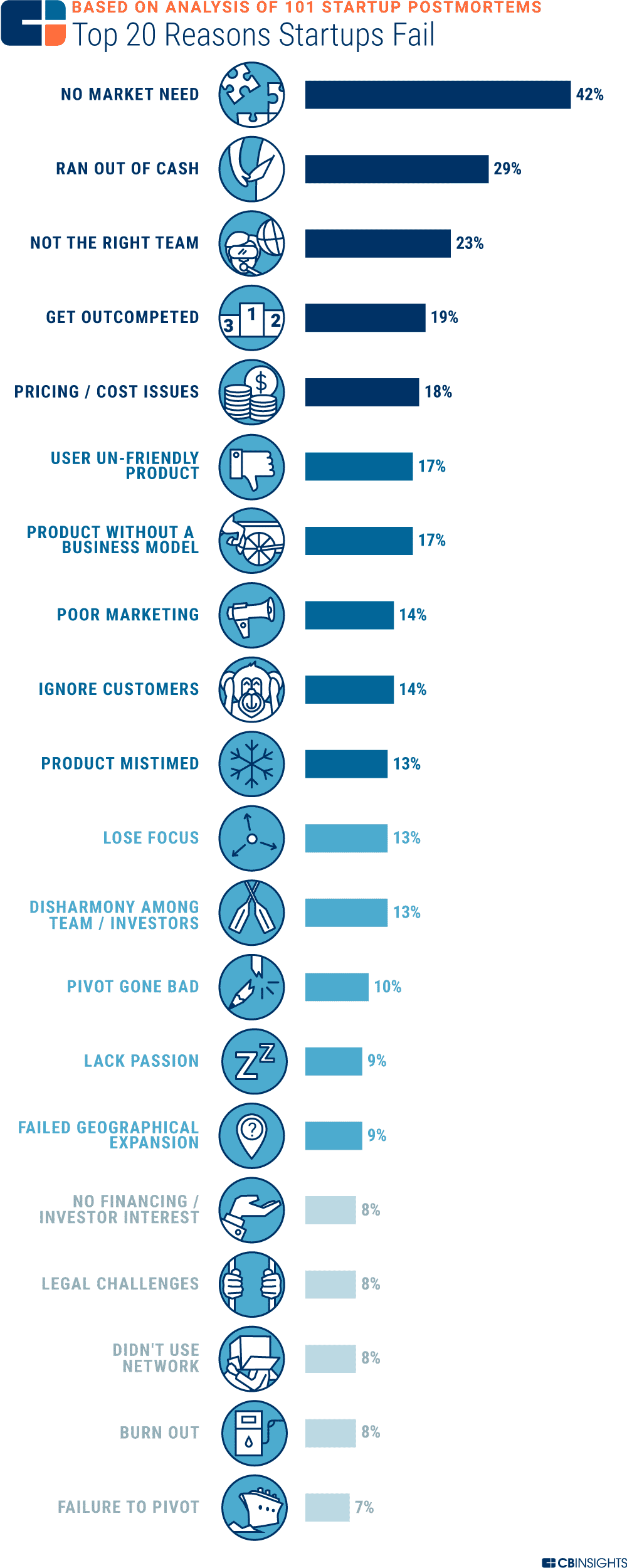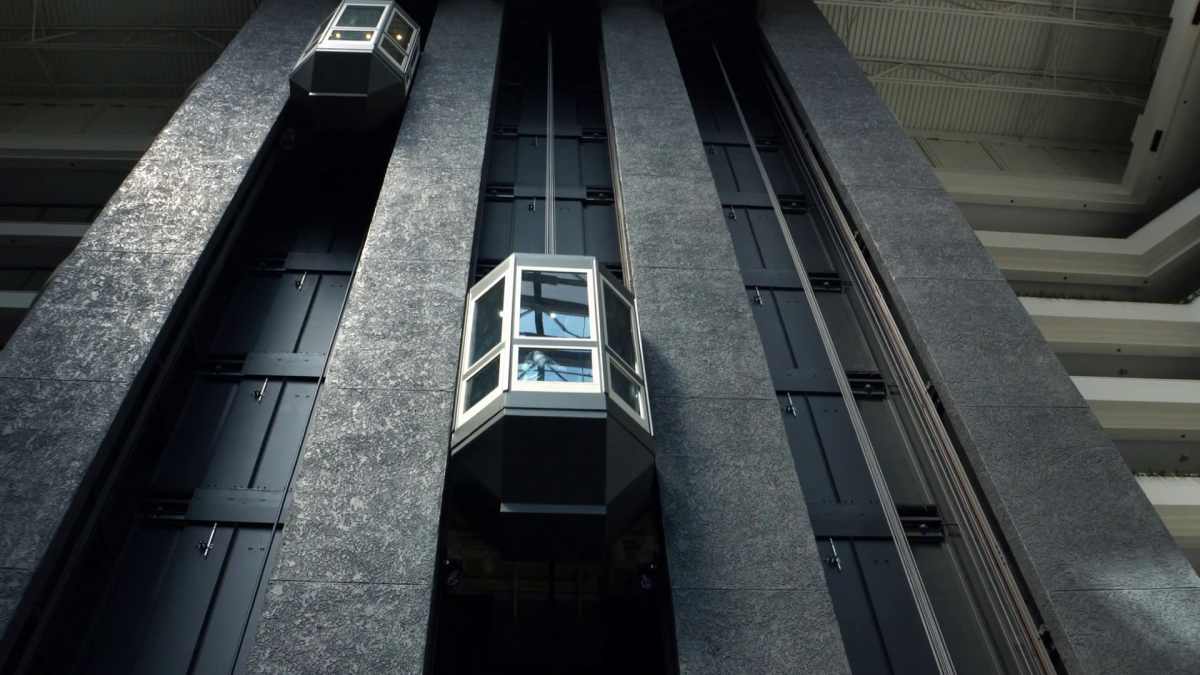A startup which failed: why do startups fail and how to prevent it.
We all have heard and continue witnessing extremely successful projects, “unicorns”. However, by studying startups which failed we can discover patterns that lead to failure and should be avoided. Welcome to the 11th article from our “Startup series”. Make sure you don’t miss the most interesting of the previous parts:
- Stages of Startup Funding – A step-by-step guide
- What is startup capital?
- Typical Startup Equity: structure, employees, percentage
- Role of CEO in a Startup – The complete list of traits
- Financials for a startup
- How to evaluate a startup
- Definition of a startup
- A Pitch Meaning in Business: what is and how to use it properly?
- Top 15 Types of Fundraising for Startups
- How to get funds for a startup in 2021 – Short guide
Eventually, it is possible to identify the exact reasons why the startups that seemed to be successful for a long time ended up failing.
According to the publication published in the print edition of FastCompany about the conducted research “Why Most Venture-Backed Companies Fail”, about 75% of all created startups that have successfully received funding from the venture direction, sooner or later close. And based on the Statistic Brain article “Startup Business Failure Rate by Industry”, we can conclude that at least 50% of companies close after a successful five-year existence and more than 70% shuts down after a decade of practice. So why do most startups fail?
Why do startups fail?
Here is a list of the most common reasons for startups which failed:
- Lack of concentration;
- Lack of motivation and creativity;
- Pride, and as a result, an inadequate response to constructive criticism;
- Following the wrong advice;
- Lack of mentorship;
- Unprofessionalism;
- Withdrawal of large assets from circulation in a short time period.
All of these factors are based on trends in business decisions made by managers. There is a more precise formulation of the reasons why startups which failed occur. It is published in the CB Insights publication “Top 20 Reasons Startups Fail”. We can indicate the next ones among them:
- No need for a product on the market;
- The project went bankrupt;
- The team was selected unprofessionally;
- Excessive competitive activity;
- An overvalued product;
- Low quality of the final product;
- Poorly thought out business model;
- Marketing is not built up to the proper level;
- Ignoring consumer requests.
It is worth noticing that all unsuccessful startups have struggled with the released product problems over time. As a result, the problems with leadership and the inability to create a strong team emerged, and the company turned out to be unable to build a business model and launch it. However, it’s wrong to claim bankruptcy the main reason for failing. As we remember, the probability to shut down the funded startup is 75%.
Examples of the startups which failed
Jawbone startup fail

This unsuccessful startup has existed since 1997, and its final blow came in 2017. In total, this project managed to attract $40 million in investment funds so its valuation at the peak reached over $300 million. Jawbone specialized in the production of compact speakers and fitness bracelets. By 2016, the general public became aware of the problems that arose in the company, in the same year the company completely stopped producing its devices. The problems at the Jawbone enterprise were so serious that the company’s management was forced to refuse help from customers.
Beepi startup fail

On the example of a very promising project Beepi, created in 2013, which existed until 2017, you can trace how not to do business. About $148 million was allocated for its implementation. In total, 35 people acted as investors.
Initially, the idea itself was very promising but this can be said about all unsuccessful startups, and this project was not saved by the idea. This is due to improper exercise. This business was based on the distribution of used cars doing it directly, without involving car dealers to reduce the costs. The official reason for the closure of this startup was incorrectly assigned priorities. As a result, the company become unprofitable and Beepi became the one more startup which failed.
Sprig startup fail

From the very beginning, this startup was very successful: the founders managed to attract approximately $57 million in investments, and during its prosperity, the average valuation corresponded to $110 million. This startup which failed in 2017 won its favor among the wealthy and sophisticated public of San Francisco despite having operated on the American market only for four years. Employees of the company provided delivery of the fast-food cooked from exclusively natural products. Initially, one condition was put forward: the food must be delivered to the customer in no later than 15 minutes. However, since the basic business model turned out to be inefficient, the project suffered a fiasco in the competition with the cheaper counterparts and Sprig’s startup failed.
Segway startup fail

The company has set itself a very ambitious goal: the founders of Segway startup attempted to create a radically new device for human movement. We are talking about two-wheeled vehicles, which could become an excellent alternative to modern cars with the condition of environmentally friendly use. The budget for the implementation of this idea amounted to $125 million. But in practice, it didn’t work out well. In other words, the price was too high to people of average income, and besides, their speed was something between driving a regular car and walking. Consumers came to the conclusion that they do not need such an innovation, since there is already a transport ready to perform these functions – a bicycle. And it, unlike the novelty, is several times cheaper and more practical. After all, the vehicle is not used as a means of transportation in the US. There is no need to purchase it if you want to try it because there is plenty of renting options in the parks.
This project appeared on the list of failed startups after Jimi Heselden, a 62-year-old millionaire and part-time owner of a Segway business, died in 2010. This tragedy occurred during his trip to the UK. The millionaire preferred personal driving, lost control of it, carried off a cliff into a mountain river.
Now Segway have the second chance and could be good a example of crisis management.
Juicero startup fail

The closure of this project took place in September 2017, thanks to its creators, it was possible to raise $119 million. All these funds were received in four stages of communication between investors in the amount of 17 persons.
Juicero lasted only 16 months, the collapse came after a devastating article published in Bloomberg.
The reporters said that the creators of Juicero juicers worth $400 produced a completely useless thing because you can use a banal manual mechanism to get juice from the bags.
Freshly squeezed juices are always a popular trend. Investors hoped that Juicero would be able to simplify the process of making a natural drink at home. But the situation looked like this: people paid separately for a juicer for $400 after which they had to buy expensive consumables in supermarkets which look like hermetically packed bags with chopped fruit inside. You can’t just take an apple and put it through a juicer. This is also a good example of a project that could be listed in the failed startups list.
Qualities that a successful startup creator should have
Researchers, after conducting a detailed analysis on the problem of how to make sure that the created project does not turn into a startup which failed, deduced several basic rules that must be followed in order for a startup to remain successful:
- the founder must work with full dedication so that their actions inspire other employees;
- have a desire to always adapt to circumstances;
- hard work and perseverance in achieving the desired goal;
- patience and ability to listen and evaluate constructive suggestions;
- do not compare yourself with competitors;
- possession of the necessary knowledge base for a productive business;
- the established balance of knowledge of the technical plan in the process of product development.
Startup which failed: Summary
In general, we can conclude that any even large and at first glance promising project may turn out to be a startup which failed, even if it has worked for a long time. Therefore, each startup leader must clearly understand the specifics of his project and the market situation in order for his company to remain successful in any conditions. And as an afterword, let me attach the CB diagram, that could be the point you should think about.




